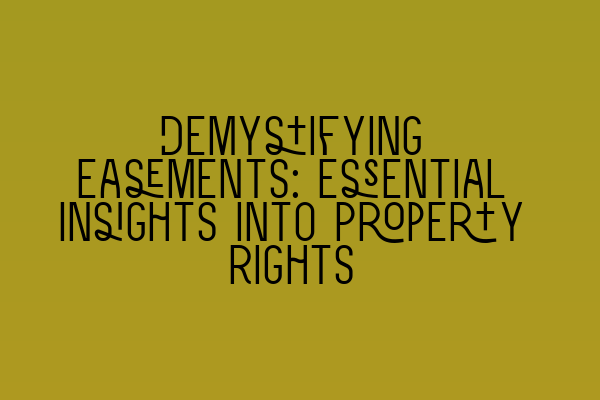Demystifying Easements: Essential Insights into Property Rights
When it comes to property law, one concept that often confuses both property owners and legal professionals is easements. In this comprehensive guide, we will demystify easements and provide you with essential insights into property rights. Whether you’re a solicitor, a property owner, or simply interested in understanding property law, this article will equip you with the knowledge you need to navigate easements with confidence.
What is an Easement?
An easement is a legal right that allows one person (known as the dominant owner) to use or access another person’s property (known as the servient owner) for a specific purpose. This legal right is attached to the land and not to the owner of the land. Easements are often created to provide necessary access to a property or to allow the smooth functioning of neighboring properties.
For a deeper understanding of easements, you may want to check out our related articles on SQE 1 practice exam questions and SQE 1 practice mocks FLK1 FLK2.
Types of Easements
There are several types of easements that can exist, each serving a different purpose:
1. Right of Way
A right of way is one of the most common types of easements and grants the dominant owner the right to pass through the servient owner’s land. This is often essential to provide access to landlocked properties or to allow the passage of utility services like water, gas, or electricity.
2. Light and Air Easements
A light and air easement grants the dominant owner the right to access natural light and maintain a particular level of airflow through the servient owner’s property. This is commonly seen in urban areas where taller buildings may obstruct sunlight or airflow for neighboring properties.
3. Drainage Easements
A drainage easement allows the dominant owner to use the servient owner’s land for drainage purposes. This is essential to prevent water buildup and flooding, especially in areas with low-lying properties.
If you’re preparing for the SQE exams or looking for preparation courses, our article on SQE 2 preparation courses and SQE 1 preparation courses may be of interest to you.
Creating an Easement
Easements can be created in several ways:
1. Express Grant
An easement can be created through an express grant, where the servient owner agrees to grant the dominant owner the right to use their property for a specific purpose. This agreement is typically documented in a written legal instrument.
2. Prescription
An easement can also be created through prescription, which is essentially a legal concept that allows someone to acquire the right to use another person’s land through continuous and uninterrupted use for a specified period of time.
3. Necessity
In some cases, an easement may be created out of necessity, such as when a property is landlocked with no other means of access. This legal principle ensures that the landlocked property has a right of way over neighboring land to ensure reasonable use and enjoyment of the property.
Terminating an Easement
Just as easements can be created, they can also be terminated. Some common ways an easement can be terminated include:
1. Agreement
An easement can be terminated if both the dominant and servient owners agree to terminate it. This agreement should be properly documented to ensure clarity and avoid any future disputes.
2. Merger
If the dominant and servient properties come under the same ownership, the easement is said to be terminated by merger. This occurs when the need for the easement ceases to exist, as the property owner has control over both properties.
3. Abandonment
An easement can also be terminated if the dominant owner voluntarily abandons their right to use the servient property. This typically involves clear and unequivocal actions that demonstrate the intent to abandon the easement.
For further information on easements, make sure to check out our related article on SRA SQE exam dates.
Conclusion
Easements are an integral part of property law, allowing for the smooth functioning and use of land. Understanding the different types of easements, how they are created, and how they can be terminated is essential for any property owner or legal professional.
If you’re preparing for the SQE exams, it’s important to have a solid understanding of property law. Our related articles on SQE 1 practice exam questions and SQE 1 practice mocks FLK1 FLK2 can help you test your knowledge and prepare effectively.
At SQE Property Law & Land Law, we are here to help you navigate the complexities of property law. If you need assistance with easements or any other property-related matters, don’t hesitate to reach out to our team of experienced solicitors. Contact us today for expert advice and guidance.
